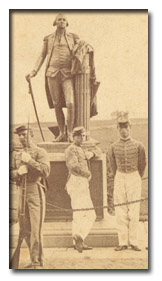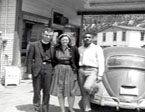Statues and Monuments at VMI
 Listed in chronological order. For detailed information about this topic, contact the Archives.
Listed in chronological order. For detailed information about this topic, contact the Archives.
- George Washington Statue (1856) View photograph
Dedicated on July 3, 1856, this bronze was cast by Virginia artist William James Hubard and is a replica of Jean Antoine Houdon's original marble. In 1864 it was confiscated by Union troops as a trophy of war, but was returned and rededicated in 1866. The statue stands across from the Washington Arch entrance to Barracks. - New Market Monument (1903) View photograph
This statue, officially named Virginia Mourning Her Dead, was created by sculptor Sir Moses Ezekiel to honor the VMI cadets who fought at the Battle of New Market. Ezekiel was himself a member of the Class of 1866 and New Market cadet. The statue was dedicated in 1903, an event that included a reunion of New Market veterans. - Francis H. Smith Statue (1931) View photograph
Bronze statue of VMI's first Superintendent, by sculptor Ferrucio Legnaioli. Smith, who served for fifty years - from the opening of the Institute in 1839 through 1889 - is known as the "builder and rebuilder" of VMI. The statue was originally located near the New Market monument, but today resides in front of Smith Hall, VMI's administration building. - Memorial Garden (1927) and Spirit of Youth (1939) View photograph
The Memorial Garden, at the front of Cocke Hall, was designed by landscape architect Ferruccio Vitale. Plaques honoring VMI Alumni who were killed in war are located in this area. The Garden includes the statue "Spirit of Youth", the work of sculptor Attilio Piccirelli. This statue was a gift of Anne Cocke, the wife of VMI's 4th Superintendent, William H. Cocke. In 2016 a memorial arch was added opposite the Spirit of Youth. - George C. Marshall Statue (1978) View photograph
Honoring VMI's distinguished 1901 graduate, this statue was dedicated on Founders Day 1978 and stands in front of the Marshall Arch section of Barracks. During World War II GEN Marshall served as Army Chief of Staff (1939–1945. After the war, he was named special ambassador to China (1945–1947), Secretary of State (1947–1949), President of the American Red Cross (1949–1950), and Secretary of Defense (1950–1951). In 1953 he was awarded the Nobel Peace Prize for his role in creating the European Recovery Program (known as the Marshall Plan). - Cincinnatus Monument (1983) View photograph
The Cincinnatus Monument stands in front of Preston Library, honoring the concept of the citizen-soldier. It includes the names of recipients of the Cincinnati Medal, awarded to the graduating cadet who "has demonstrated to the greatest degree excellence of character and efficient of service" - Jackson-Hope Monument (2003) View photograph
Honoring the recipients of the First Jackson-Hope Medal and the Second Jackson-Hope Medal, awarded to the two most academically distinguished cadets in each graduating class since 1876 - Jonathan Daniels Barracks Arch and Courtyard (2006) View detailed information and photographs
Daniels, from Keene, New Hampshire, was the valedictorian of the Class of 1961. While a seminarian at the Episcopal Divinity School in Cambridge, Massachusetts he responded to the pleas of Dr. Martin Luther King for clergy to become more actively involved in the Civil Rights movement, and traveled to Alabama to assist with voter registration efforts in the South. He was shot and killed in Hayneville, Alabama in August 1965.
Other items: Artillery
- Cannon along Parapet Wall View photograph
There are eight cannon along the Parapet wall opposite the Washington Arch of Barracks. Six are original 17th century French bronze guns. Two are 12-pound cannon from the Letcher Artillery; the tubes were cast at Tredegar Foundry in Richmond from bronze salvaged from the melting down of Revolutionary War era French cannon. The Letcher Artillery cannon were presented to VMI in 1863. - Cadet Battery (Jackson's Battery) View photograph
This custom-designed battery was cast at the Cyrus Alger Foundry in Boston and arrived at VMI on June 6, 1848. From 1851 until the beginning of the Civil War the guns were commanded by Major Thomas J. Jackson (later known as "Stonewall"), VMI's professor of Natural Philosophy and Artillery Tactics. During the war the guns were used by several units, including the famed Rockbridge Artillery under the command of William Pendleton. It was Pendleton, an Episcopal minister, who named the four cannon Matthew, Mark, Luke, and John.
.svg)
.png)
